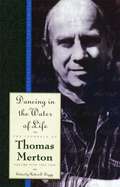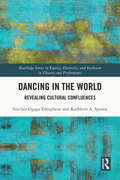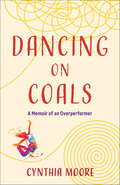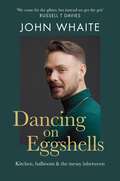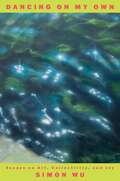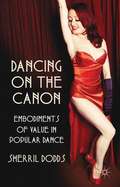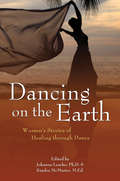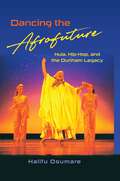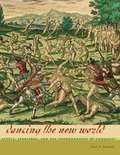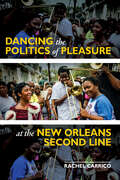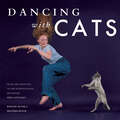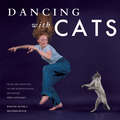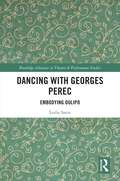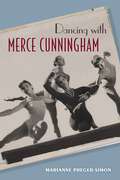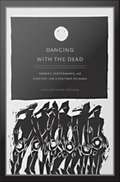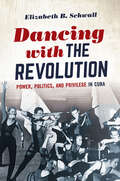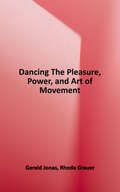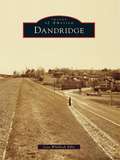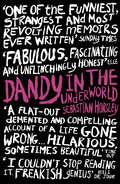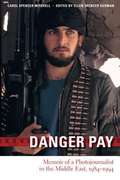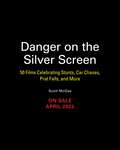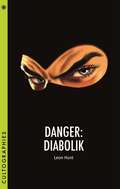- Table View
- List View
Dancing in the Water of Life
by Thomas MertonThe sixties were a time of restlessness, inner turmoil, and exuberance for Merton during which he closely followed the careening development of political and social activism - Martin Luther King, Jr., and the March on Selma, the Catholic Worker Movement, the Vietnam war, and the assassination of John F. Kennedy. Volume 5 chronicles the approach of Merton's fiftieth birthday and marks his move to Mount Olivet, his hermitage at the Abbey of Gethsemani, where he was finally able to fully embrace the joys and challenges of solitary life: 'In the hermitage, one must pray of go to seed. The pretense of prayer will not suffice. Just sitting will not suffice . . . Solitude puts you with your back to the wall (or your face to it!), and this is good' (13 October, 1964).
Dancing in the Water of Life
by Thomas MertonThe sixties were a time of restlessness, inner turmoil, and exuberance for Merton during which he closely followed the careening development of political and social activism - Martin Luther King, Jr., and the March on Selma, the Catholic Worker Movement, the Vietnam war, and the assassination of John F. Kennedy. Volume 5 chronicles the approach of Merton's fiftieth birthday and marks his move to Mount Olivet, his hermitage at the Abbey of Gethsemani, where he was finally able to fully embrace the joys and challenges of solitary life: 'In the hermitage, one must pray of go to seed. The pretense of prayer will not suffice. Just sitting will not suffice . . . Solitude puts you with your back to the wall (or your face to it!), and this is good' (13 October, 1964).
Dancing in the World: Revealing Cultural Confluences (Routledge Series in Equity, Diversity, and Inclusion in Theatre and Performance)
by Sinclair Ogaga Emoghene Kathleen A. SpanosHow can we create more inclusive spaces in the field of dance? This book presents a framework for dance practitioners and researchers working in diverse dance cultures to navigate academia and the professional dance field. The framework is based on the idea of "cultural confluences," conjuring up an image of bodies of water meeting and flowing into and past one another, migrating through what they refer to as the mainstream and non-mainstream. These streams are fluid categories that are associated with power, privilege, and the ability (or inability) to absorb other cultural forms in shared dance spaces. In reflective interludes and dialogues, Emoghene and Spanos consider the effects of migration on their own individual experiences in dance to understand what it means to carry culture through the body in various spaces. Through an analysis of language, aesthetic values, spaces, creative processes, and archival research practices, the book offers a collaborative model for communicating the value that marginalized dance communities bring to the field. This book will be of great interest to students, scholars, and arts administrators in dance.
Dancing on Coals: A Memoir of an Overperformer
by Cynthia MooreAn award-winning playwright's story of her madcap race to find fame or enlightenment, whichever comes first— perfect for fans of Lori Gottlieb's Maybe You Should Talk to Someone.In Dancing on Coals, Cynthia Moore describes a multi-decade, harebrained search for love in all the wrong places, starting when her narcissistic mother abandons her to a Swiss finishing school. Desperately seeking belonging, she leapfrogs from a polyamorous commune into a high-octane all-male performance group, dancing as if her life depends on it. When she finally quits the theater, earns a masters degree in psychology and develops her own therapeutic approach, she is able to heal herself and find the true belonging and peace she longs for. At times humorous and self-deprecating, at times poignant and heartbreaking, this is the story of one woman's path from abandonment to wholeness and authenticity.
Dancing on Eggshells: Kitchen, ballroom & the messy inbetween
by John Whaite'We come for the glitter, but instead we get the grit, in stories told with insight, tenderness and joy.' - Russell T DaviesWith a foreword by Steph McGovern'I never thought I'd write a memoir. I never thought I'd do a lot of the things I have done in my thirty-four years, but life has a wonderful way of surprising us.'Well-known as the winner of the third series of The Great British Bake Off and runner up of Strictly Come Dancing with his same-sex dance partner Johannes Radebe, John Whaite's personal story is a complicated narrative of contradictions, highs and lows, told with tenderness, joy, insight and wit, but also unflinching honesty. A shy little boy from rural Lancashire, who was scared to sleep alone and danced a little 'too gay' at family weddings, he was also an unruly teen who shaved a checkerboard pattern into his hair and refused to conform. From childhood his life has revolved around food - his parents owned a fish and chip shop where John worked in the back peeling potatoes - but for long periods he has been haunted by bulimia and body dysmorphia and not a day goes by when he doesn't worry about what or how much he eats. He achieved TV fame but then seemingly wilfully chose to self-destruct, before finding the strength to pull back when he woke up in a car with half a kebab at his feet and chilli sauce on his shoes. Through it all, his essential optimism has meant that he has chosen to take every step back as a chance to reassess and begin again, finally arriving at the realisation that external validation and fulfilment is transient - a distraction from the sometimes painful pilgrimage we make as we gain wisdom from our experiences.
Dancing on Eggshells: Kitchen, ballroom & the messy inbetween
by John Whaite'We come for the glitter, but instead we get the grit, in stories told with insight, tenderness and joy.' - Russell T DaviesWith a foreword by Steph McGovern'I never thought I'd write a memoir. I never thought I'd do a lot of the things I have done in my thirty-four years, but life has a wonderful way of surprising us.'Well-known as the winner of the third series of The Great British Bake Off and runner up of Strictly Come Dancing with his same-sex dance partner Johannes Radebe, John Whaite's personal story is a complicated narrative of contradictions, highs and lows, told with tenderness, joy, insight and wit, but also unflinching honesty. A shy little boy from rural Lancashire, who was scared to sleep alone and danced a little 'too gay' at family weddings, he was also an unruly teen who shaved a checkerboard pattern into his hair and refused to conform. From childhood his life has revolved around food - his parents owned a fish and chip shop where John worked in the back peeling potatoes - but for long periods he has been haunted by bulimia and body dysmorphia and not a day goes by when he doesn't worry about what or how much he eats. He achieved TV fame but then seemingly wilfully chose to self-destruct, before finding the strength to pull back when he woke up in a car with half a kebab at his feet and chilli sauce on his shoes. Through it all, his essential optimism has meant that he has chosen to take every step back as a chance to reassess and begin again, finally arriving at the realisation that external validation and fulfilment is transient - a distraction from the sometimes painful pilgrimage we make as we gain wisdom from our experiences.
Dancing on My Own: Essays on Art, Collectivity, and Joy
by Simon WuA The Millions and Hyperallergic Most Anticipated Book of 2024 | A Publishers Weekly Summer Reads Pick“Simon Wu manages to be both a shrewd critic and enthused aspirant of what passes for today’s cultural capital. . . . with a disarming lack of cynicism that is both keen and refreshing.” –Cathy Park Hong"A genius melding of art criticism, autobiography, personal essay, and travel writing. . . . Wu—an artist, curator, and writer—layers experiences like translucent curtains through which we see the landscape of a past in the present making its future." –Claudia RankineAn expansive and deeply personal essay collection which explores the aesthetics of class aspiration, the complications of creating art and fashion, and the limits of identity politics.In Robyn’s 2010 track Dancing on My Own, the Swedish pop-singer chronicles a night on the dance floor in the shadow of a former lover. She is bitter, angry, and at times desperate, and yet by the time the chorus arrives her frustration has melted away. She decides to dance on her own, and in this way, she transforms her solitude into a more complex joy. Taking inspiration from Robyn’s seminal track, emerging art critic and curator Simon Wu dances through the institutions of art, capitalism, and identity in these expertly researched, beautifully rendered essays. In “A Model Childhood” he catalogs the decades’ worth of clutter in his mother’s suburban garage and its meaning for himself and his family. In “For Everyone,” Wu explores the complicated sensation of the Telfar bag (often referred to as “the Brooklyn Birkin”) and asks whether fashion can truly be revolutionary in a capitalist system—if something can truly be “for everyone” without undercutting someone else. Throughout, Wu centers the sticky vulnerability of living in a body in a world where history is mapped into every choice we make, every party drug we take, and every person we kiss.Wu’s message is that to dance on your own is to move from critique into joy. To approach identity with the utmost sympathy for the kinds of belonging it might promise, and to look beyond it. For readers of Cathy Park Hong and Alexander Chee, Dancing on My Own is a deeply felt and ultimately triumphant anthem about the never-ending journey of discovering oneself, and introduces a brilliant new writer on the rise.
Dancing on the Canon
by Sherril DoddsEmploying a cultural theory approach, thisbook explores the relationship between popular dance and value. It traces the shifting value systems that underpin popular dance scholarship and considers how different dancing communities articulate complex expressions of judgment, significance and worth through their embodied practice. "
Dancing on the Earth
by Sandra Mcmaster Johanna LesehoThe essays in this dynamic compilation are a testament to dance as a healing art. Widely interdisciplinary in nature and written by women dancers from around the world, they illustrate a rich array of dance practices, cultures, and disciplines and show how this expressive therapy can be both empowering and exhilarating. The women's narratives all share a deep appreciation for the connection between mental, spiritual, and physical dimensions, offering dance as a transformative power of renewing and rebuilding that bond. Both personal and professional, the stories weave a vivid tapestry of lived experiences and insights, balance, and a community healed by dance.
Dancing the Afrofuture: Hula, Hip-Hop, and the Dunham Legacy
by Halifu Osumare<p class="MsoNormal" style="margin-bottom:0in;margin-bottom:.0001pt;line-height: normal;mso-pagination:none;mso-layout-grid-align:none;text-autospace:none"><span style="font-size:12.0pt;font-family: "Times New Roman",serif">A Black dancer chronicles her career as a scholar writing the stories of global hip-hop and Black culture <p class="MsoNormal" style="margin-bottom:0in;margin-bottom:.0001pt;line-height: normal;mso-pagination:none;mso-layout-grid-align:none;text-autospace:none"> <p class="MsoNormal" style="margin-bottom:0in;margin-bottom:.0001pt;line-height: normal;mso-pagination:none;mso-layout-grid-align:none;text-autospace:none">Dancing the Afrofuture is the story of a dancer with a long career of artistry and activism who transitioned from performing Black dance to writing it into history as a Black studies scholar. Following the personal journey of her artistic development told in Dancing in Blackness, Halifu Osumare now reflects on how that first career—which began during the 1960s Black Arts Movement—has influenced her growth as an academic, tracing her teaching and research against a political and cultural backdrop that extends to the twenty-first century with Black Lives Matter and a potent speculative Afrofuture. <p class="MsoNormal" style="margin-bottom:0in;margin-bottom:.0001pt;text-indent: .5in;line-height:normal">Osumare describes her decision to step away from full-time involvement in dance and community activism to earn a doctorate in American studies from the University of Hawai‘i. She emulated the model of her mentor Katherine Dunham by studying and performing hula, and her research on hip-hop youth culture took her from Hawai‘i to Africa, Europe, and South America as a professor at the University of California, Davis. Throughout her scholarly career, Osumare has illuminated the resilience of African-descendant peoples through a focus on performance and the lens of Afrofuturism. <p class="MsoNormal" style="margin-bottom:0in;margin-bottom:.0001pt;text-indent: .5in;line-height:normal">Respected for her work as both professional dancer and trailblazing academic, Osumare shares experiences from her second career that show the potential of scholarship in revealing and documenting underrecognized stories of Black dance and global pop culture. In this memoir, Osumare dances across several fields of study while ruminating on how the Black past reveals itself in the Afro-present that is transforming into the Afrofuture. <p class="MsoNormal" style="margin-bottom:0in;margin-bottom:.0001pt;line-height: normal"> <p class="MsoNormal" style="margin-bottom:0in;margin-bottom:.0001pt;line-height: normal">Publication of this work made possible by a Sustaining the Humanities through the American Rescue Plan grant from the National Endowment for the Humanities and a University of California, Davis Edward A. Dickson Emeriti Professorship Award.
Dancing the New World: Aztecs, Spaniards, and the Choreography of Conquest
by Paul A. ScolieriFrom Christopher Columbus to "first anthropologist" Friar Bernardino de Sahagún, fifteenth- and sixteenth-century explorers, conquistadors, clerics, scientists, and travelers wrote about the "Indian" dances they encountered throughout the New World. This was especially true of Spanish missionaries who intensively studied and documented native dances in an attempt to identify and eradicate the "idolatrous" behaviors of the Aztec, the largest indigenous empire in Mesoamerica at the time of its European discovery. Dancing the New World traces the transformation of the Aztec empire into a Spanish colony through written and visual representations of dance in colonial discourse-the vast constellation of chronicles, histories, letters, and travel books by Europeans in and about the New World. Scolieri analyzes how the chroniclers used the Indian dancing body to represent their own experiences of wonder and terror in the New World, as well as to justify, lament, and/or deny their role in its political, spiritual, and physical conquest. He also reveals that Spaniards and Aztecs shared an understanding that dance played an important role in the formation, maintenance, and representation of imperial power, and describes how Spaniards compelled Indians to perform dances that dramatized their own conquest, thereby transforming them into colonial subjects. Scolieri's pathfinding analysis of the vast colonial "dance archive" conclusively demonstrates that dance played a crucial role in one of the defining moments in modern history-the European colonization of the Americas.
Dancing the Politics of Pleasure at the New Orleans Second Line
by Rachel CarricoOn many Sundays, Black New Orleanians dance through city streets in Second Lines. These processions invite would-be spectators to join in, grooving to an ambulatory brass band for several hours. Though an increasingly popular attraction for tourists, parading provides the second liners themselves with a potent public expression of Black resistance. Rachel Carrico examines the parading bodies in motion as a form of negotiating and understanding power. Seeing pleasure as a bodily experience, Carrico reveals how second liners’ moves link joy and liberation, self and communal identities, play and dissent, and reclamations of place. As she shows, dancers’ choices allow them to access the pleasure of reclaiming self and city through motion and rhythm while expanding a sense of the possible in the present and for the future. In-depth and empathetic, Dancing the Politics of Pleasure at the New Orleans Second Line blends analysis with a chorus of Black voices to reveal an indelible facet of Black culture in the Crescent City.
Dancing with Cats: From The Creators Of The International Best Seller Why Cats Paint
by Heather Busch Burton SilverThe cult classic is back! This 15th anniversary edition keeps all the original mystery and magic of cat dancing delightfully intact. Perpetually ahead of its time, Dancing with Cats presents scores of delightful and inspiring photographs of people and cats engaging in their favorite dance routines as well as moving testimonies of the personal transformations brought about through this uniquely joyous form of human-animal connection. Dancing with Cats will have a new generation of cat lovers (and their cats) jumping for joy--and cutting a rug--in no time.
Dancing with Cats: From the Creators of the International Best Seller Why Cats Paint
by Heather Busch Burton SilverThe cult classic is back! This 15th anniversary edition keeps all the original mystery and magic of cat dancing delightfully intact. Perpetually ahead of its time, Dancing with Cats presents scores of delightful and inspiring photographs of people and cats engaging in their favorite dance routines as well as moving testimonies of the personal transformations brought about through this uniquely joyous form of human-animal connection. Dancing with Cats will have a new generation of cat lovers (and their cats) jumping for joy—and cutting a rug—in no time.
Dancing with Georges Perec: Embodying Oulipo (ISSN)
by Leslie SatinThis book explores the relationship of the life and work of the remarkable Parisian-Jewish writer Georges Perec (1936–1983) to dance."Dancing" addresses art-making parallels and their personal and sociocultural contexts, including Perec’s childhood loss of his parents in the Holocaust and its repercussions in the significance of the body, everydayness, space, and attention permeating his work. This book, emerging from the author Leslie Satin’s perspective as a dancer and scholar, links Perec’s concerns with those of dance and demonstrates that Perec’s work has implications for dance and how we think about it. Moreover, it is framed as a performative autobiographical enactment of the author's relationship to Perec, periodically linking their written, danced, and imagined lives.This exploration will be of great interest to dancers, dance scholars, and dance students interested in contemporary experimental dance and contemporary dance.
Dancing with Merce Cunningham
by Marianne Preger-SimonDancing with Merce Cunningham is a buoyant, captivating memoir of a talented dancer’s lifelong friendship with one of the choreographic geniuses of our time. Dancing with Merce Cunningham is a buoyant, captivating memoir of a talented dancer’s lifelong friendship with one of the choreographic geniuses of our time. Marianne Preger-Simon’s story opens amid the explosion of artistic creativity that followed World War II. While immersed in the vibrant arts scene of postwar Paris during a college year abroad, Preger-Simon was so struck by Merce Cunningham’s unconventional dance style that she joined his classes in New York. She soon became an important member of his brand new dance troupe—and a constant friend. Through her experiences in the Merce Cunningham Dance Company, Preger-Simon offers a rare account of exactly how Cunningham taught and interacted with his students. She describes the puzzled reactions of audiences to the novel non-narrative choreography of the company’s debut performances. She touches on Cunningham’s quicksilver temperament—lamenting his early frustrations with obscurity and the discomfort she suspects he endured in concealing his homosexuality and partnership with composer John Cage—yet she celebrates above all his dependable charm, kindness, and engagement. She also portrays the comradery among the company’s dancers, designers, and musicians, many of whom—including Cage, David Tudor, and Carolyn Brown—would become integral to the avant-garde arts movement, as she tells tales of their adventures touring in a VW Microbus across the United States. Finally, reflecting on her connection with Cunningham throughout the latter part of his career, Preger-Simon recalls warm moments that nurtured their enduring bond after she left the dance company and, later, New York. Interspersed with her letters to friends and family, journal entries, and correspondence from Cunningham himself, Preger-Simon’s memoir is an intimate look at one of the most influential companies in modern American dance and the brilliance of its visionary leader.
Dancing with the Dead: Memory, Performance, and Everyday Life in Postwar Okinawa
by Christopher NelsonChallenging conventional understandings of time and memory, Christopher T. Nelson examines how contemporary Okinawans have contested, appropriated, and transformed the burdens and possibilities of the past. Nelson explores the work of a circle of Okinawan storytellers, ethnographers, musicians, and dancers deeply engaged with the legacies of a brutal Japanese colonial era, the almost unimaginable devastation of the Pacific War, and a long American military occupation that still casts its shadow over the islands. The ethnographic research that Nelson conducted in Okinawa in the late 1990s--and his broader effort to understand Okinawans' critical and creative struggles--was inspired by his first visit to the islands in 1985 as a lieutenant in the U. S. Marine Corps. Nelson analyzes the practices of specific performers, showing how memories are recalled, bodies remade, and actions rethought as Okinawans work through fragments of the past in order to reconstruct the fabric of everyday life. Artists such as the popular Okinawan actor and storyteller Fujiki Hayato weave together genres including Japanese stand-up comedy, Okinawan celebratory rituals, and ethnographic studies of war memory, encouraging their audiences to imagine other ways to live in the modern world. Nelson looks at the efforts of performers and activists to wrest the Okinawan past from romantic representations of idyllic rural life in the Japanese media and reactionary appropriations of traditional values by conservative politicians. In his consideration of eisā, the traditional dance for the dead, Nelson finds a practice that reaches beyond the expected boundaries of mourning and commemoration, as the living and the dead come together to create a moment in which a new world might be built from the ruins of the old.
Dancing with the Revolution: Power, Politics, and Privilege in Cuba (Envisioning Cuba)
by Elizabeth B. SchwallElizabeth B. Schwall aligns culture and politics by focusing on an art form that became a darling of the Cuban revolution: dance. In this history of staged performance in ballet, modern dance, and folkloric dance, Schwall analyzes how and why dance artists interacted with republican and, later, revolutionary politics. Drawing on written and visual archives, including intriguing exchanges between dancers and bureaucrats, Schwall argues that Cuban dancers used their bodies and ephemeral, nonverbal choreography to support and critique political regimes and cultural biases.As esteemed artists, Cuban dancers exercised considerable power and influence. They often used their art to posit more radical notions of social justice than political leaders were able or willing to implement. After 1959, while generally promoting revolutionary projects like mass education and internationalist solidarity, they also took risks by challenging racial prejudice, gender norms, and censorship, all of which could affect dancers personally. On a broader level, Schwall shows that dance, too often overlooked in histories of Latin America and the Caribbean, provides fresh perspectives on what it means for people, and nations, to move through the world.
Dancing: The Pleasure, Power, and Art of Movement
by Gerald JonasLooks at the history of dance, dance around the world, and influential dancers and choreographers of the past and present.
Dandridge (Images of America)
by Lisa Whillock EllisDandridge, Tennessee, the second-oldest town in the state, was founded in 1783 by a group of Scotch-Irish settlers. It was 13 years before Tennessee became the 16th state. The town began as a small frontier settlement along the banks of the French Broad River in the short-lived state of Franklin. In 1793, Dandridge became the county seat for the newly formed Jefferson County. The county was named for then U.S. secretary of state Thomas Jefferson. Dandridge is the only town in the United States named for first lady Martha Dandridge Custis Washington. Davy Crockett married his first wife near Dandridge, and the courthouse still has his marriage bond in its archives. Over the years, it has played host to presidents Andrew Jackson, James K. Polk, and Andrew Johnson. During the Civil War, the Battle of Dandridge was fought there in winter 1864. In 1942, the town was saved when the Tennessee Valley Authority built a dike to protect it from the waters of Douglas Lake.
Dandy in the Underworld: A Memoir
by Sebastian Horsley'Like Salvador Dali's confessions, only far funnier and more self-deprecating, Dandy in the Underworld entertains as much as it revolts, is as tender as it is shocking, and as genuine as it is false.' IndependentSure to shock and surprise, Sebastian Horsley recounts his life story with excruciating self-knowledge and a savage wit.'One of the funniest, strangest and most revolting memoirs ever written.' Sunday TimesGrowing up at High Hall, in Hull, with his alcoholic mother, who regularly attempted suicide, his stepfather, a cult member dressed in orange, and his father, a crippled millionaire, Sebastian Horsley couldn't wait to leave home. Searching for happiness, meaning and a good outfit he embarked on a doomed career as a punk guitarist, had a stormy relationship with a notorious Scottish gangster, enjoyed a wildly successful period as a stock-market entrepeneur and experienced a near fatal stint as a shark-hunter. Sebastian charts his years as a dandy, an artist, a male escort and a brothel connoisseur. There are the love affairs, with Rachel 1 and Rachel 2, and a harrowing descent into heroin and crack addiction. Dandy in the Underworld evokes his desperate attempts to get clean, culminating in his crucifixion in the Philippines.
Dandy in the Underworld: A Memoir (P. S. Ser.)
by Sebastian Horsley'Like Salvador Dali's confessions, only far funnier and more self-deprecating, Dandy in the Underworld entertains as much as it revolts, is as tender as it is shocking, and as genuine as it is false.' IndependentSure to shock and surprise, Sebastian Horsley recounts his life story with excruciating self-knowledge and a savage wit.'One of the funniest, strangest and most revolting memoirs ever written.' Sunday TimesGrowing up at High Hall, in Hull, with his alcoholic mother, who regularly attempted suicide, his stepfather, a cult member dressed in orange, and his father, a crippled millionaire, Sebastian Horsley couldn't wait to leave home. Searching for happiness, meaning and a good outfit he embarked on a doomed career as a punk guitarist, had a stormy relationship with a notorious Scottish gangster, enjoyed a wildly successful period as a stock-market entrepeneur and experienced a near fatal stint as a shark-hunter. Sebastian charts his years as a dandy, an artist, a male escort and a brothel connoisseur. There are the love affairs, with Rachel 1 and Rachel 2, and a harrowing descent into heroin and crack addiction. Dandy in the Underworld evokes his desperate attempts to get clean, culminating in his crucifixion in the Philippines.
Danger Pay
by Carol Spencer Mitchell"You're going where?" Carol Spencer Mitchell's father demanded as she set off in 1984 to cover the Middle East as a photojournalist for Newsweek and other publications. In this intensely thoughtful memoir, Spencer Mitchell probes the motivations that impelled her, a single, Jewish woman, to document the turmoil roiling the Arab world in the 1980s and 1990s, as well as how her experiences as a photojournalist "compelled [me] to set aside [my] cameras and reexamine the way images are created, scenes are framed, and how 'real life' is packaged for specific news stories. " In Danger Pay, Spencer Mitchell takes us on a harrowing journey to PLO military training camps for Palestinian children and to refugee camps in the Gaza Strip before, during, and after the first intifada. Through her eyes, we experience the media frenzy surrounding the 1985 hijackings of TWA Flight #847 and the Italian cruise liner Achille Lauro. We meet Middle Eastern leaders, in particular Yasser Arafat and King Hussein of Jordan, with whom Spencer Mitchell developed close working relationships. And we witness Spencer Mitchell's growing conviction that the Western media's portrayal of conflicts in the Middle East actually helps to fuel those conflicts-a conviction that eventually, as she says, "shattered my career. " Although the events that Spencer Mitchell records took place a generation ago, their repercussions reverberate in the conflicts going on in the Middle East today. Likewise, her concern about "the triumph of image over reality" takes on greater urgency as our knowledge of the world becomes ever more filtered by virtual media.
Danger on the Silver Screen: 50 Films Celebrating Cinema's Greatest Stunts (Turner Classic Movies)
by Scott McGeeTurner Classic Movies presents a heart-racing look into the world of stunt work featuring films that capture the exhilaration of a car chase, the comedy of a well timed prat fall, or the adrenaline rush from a fight scene complete with reviews, behind-the-scenes stories, and hundreds of photographs.Buckle in and join TCM on a action-packed journey through the history of cinema stunt work in Danger on the Silver Screen. This action-packed guide profiles 50 foundational films with insightful commentary on the history, importance, and evolution of an often overlooked element of film: stunt work. With insightful commentary and additional recommendations to expand your repertoire based on your favorites, Danger on the Silver Screen is a one-of-a-kind guide, perfect for film lovers to learn more about or just brush up on their knowledge of stunt work and includes films such as Ben-Hur (1925 & 1959), The Great K&A Train Robbery (1926), Steamboat Bill Jr. (1928), The Thing from Another World (1951), Bullitt (1968), Live and Let Die (1973), The Blues Brothers (1980), Romancing the Stone (1984), The Matrix (1999), The Bourne Supremacy (2004), John Wick (2014), Mission: Impossible—Rogue Nation (2015), Atomic Blonde (2017), and many more.
Danger: Diabolik (Cultographies)
by Leon HuntDanger: Diabolik (1968) was adapted from a comic that has been a social phenomenon in Italy for over fifty years, featuring a masked master criminal—part Fantômas, part James Bond—and his elegant companion Eva Kant. The film partially reinvents the character as a countercultural prankster, subverting public officials and the national economy, and places him in a luxurious and futuristic underground hideout and Eva in a series of unforgettable outfits. A commercial disappointment on its original release, Danger: Diabolik's reputation has grown along with that of its director, Mario Bava, the quintessential cult auteur, while the pop-art glamour of its costumes and sets have caught the imagination of such people as Roman Coppola and the Beastie Boys.This study examines its status as a comic-book movie, including its relation both to the original fumetto and to its sister-film, Barbarella. It traces its production and initial reception in Italy, France, the U.S., and the UK, and its cult afterlife as both a pop-art classic and campy "bad film" featured in the final episode of Mystery Science Theatre 3000.
